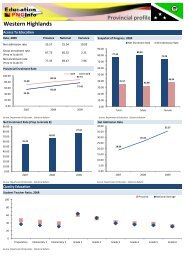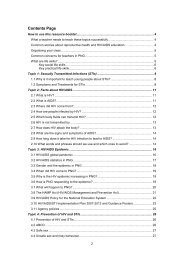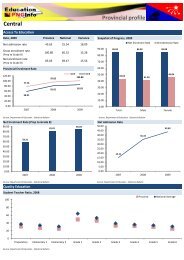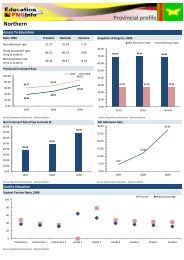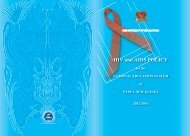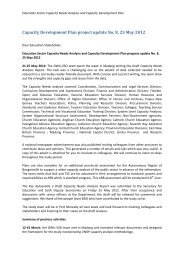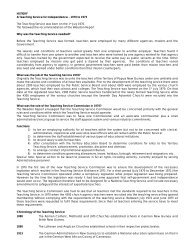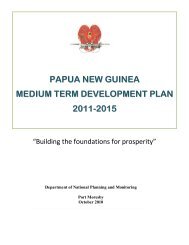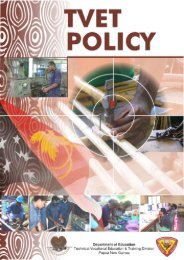Health Education to Prevent HIV/AIDS & STIs - Department of ...
Health Education to Prevent HIV/AIDS & STIs - Department of ...
Health Education to Prevent HIV/AIDS & STIs - Department of ...
Create successful ePaper yourself
Turn your PDF publications into a flip-book with our unique Google optimized e-Paper software.
<strong>Department</strong> <strong>of</strong> <strong>Education</strong> TVET Division<br />
<strong>HIV</strong>/<strong>AIDS</strong> & STI Teacher Guide<br />
People show no signs and symp<strong>to</strong>ms <strong>of</strong> <strong>HIV</strong> infection<br />
People can be infected for a long time<br />
<strong>AIDS</strong> is when the immune system is badly damaged<br />
Opportunistic infections include pneumonia, malaria, diarrhoea, TB,<br />
common cold, sores that won’t heal, thrush etc.<br />
Root causes <strong>of</strong> the <strong>HIV</strong> epidemic in PNG include gender inequality,<br />
poverty, broken families, abuse and rape, sexual violence, polygamy, drug<br />
and alcohol abuse, migration and mobility, poor health care, low condom<br />
use, high STI rates, cultural taboos and practices (including bride price) etc<br />
Latest figures by age and sex<br />
Latest quarterly <strong>to</strong>tal <strong>of</strong> new infections<br />
Trends in the figures<br />
All Provinces and all age groups affected<br />
Critical analysis <strong>of</strong> the data (e.g. unreported cases, places where there<br />
many testing sites, difficulty in collecting data)<br />
Vulnerable groups include women and children, young people, middle aged<br />
men, mobile working people, polygamous relationships, sex workers and<br />
their clients etc<br />
Young women are vulnerable because they are sexually active, may not<br />
complete education, married young <strong>to</strong> older men, inability <strong>to</strong> negotiate for<br />
safer sex, limited money, peer pressure, cultural fac<strong>to</strong>rs, rape, violence and<br />
abuse etc<br />
Young men are vulnerable because sexually active, cultural and peer<br />
pressure <strong>to</strong> have lots <strong>of</strong> sexual partners, alcohol and drug abuse, violence<br />
and poverty etc<br />
Possible future impacts include lot <strong>of</strong> deaths and sickness, economic<br />
pressure on families, loss <strong>of</strong> students and teachers, young women and girls<br />
leave school <strong>to</strong> care for relatives, orphans, huge pressure on a weak health<br />
care system etc<br />
Common <strong>STIs</strong>, their germs, signs and symp<strong>to</strong>ms and treatments syphilis,<br />
gonorrhoea, Chlamydia, PID, hepatitis, herpes, donovanosis, genital warts,<br />
thrush<br />
Having an STI increases your chance <strong>of</strong> getting <strong>HIV</strong><br />
Delivery Strategy for the Module<br />
13





